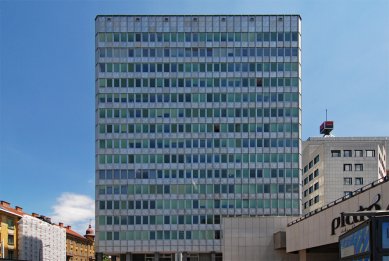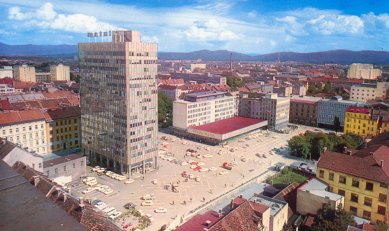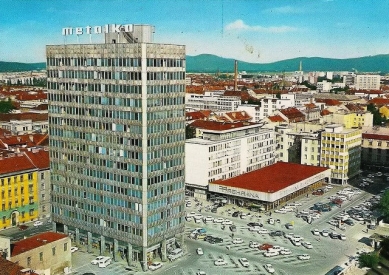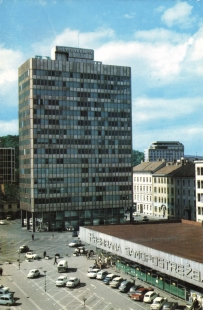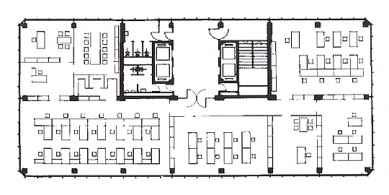
Commercial building Metalka
Business Building Metalke

Metalka is the second tall building on the main Ljubljana boulevard in Slovenia after Šubic's Nebotičnik. Approximately one hundred meters north of Nebotičnik, another skyscraper was built in the center of Ljubljana after thirty years, which, however, did not reach the same height as it and was ten meters shorter than the first tall building in the Balkans. The title of the tallest Slovenian building was taken from Nebotičnik in the 1970s by Ravnikar's twins at today's Republic Square. While Šubic's skyscraper still adhered to Sullivan's principles of three-part division, Edo Mihevc, although a student of Plečnik, was inspired by the clean lines of Burnshaft's Lever House (1952) and, above all, by Mies's Seagram Building (1958).
Metalka is an example of a rapidly growing trading company that wanted to let everyone know about its success and showcase its power to the city's residents. The skyscraper, which architect Edvard Mihevc built for Metalka at the turn of the 1950s and 1960s, was meant to represent the significance of the company, which, of course, could not be done without the tacit approval of politicians, and its sovereign role in a distorted economy. Mihevc decided to use the proven 'Miesesque' model of a simple, slender block revealing its construction behind a uniform hanging facade to address the controversial task that was attracting considerable attention and criticism at the time. The height of the building was predetermined due to the protection of the overall panorama of the city, which was until then dominated by Baroque bell towers, the castle hill, and also the newly erected Nebotičnik, which was a symbol of the modern expanding city. In the story of Ljubljana's skyscrapers, Metalka represents the arrival of a new and rapid construction solution, which from the 1960s set the standard for administrative buildings around the world. However, Mihevc's approach was different in its closer involvement with industrial design, which is most evident in the hanging aluminum shell designed by Branko Kraševac. The supply of the structure was taken care of by the Slovenian company Impol, transforming the building into a showcase for the technological progress of the trader. Following the model of the Seagram Building, Metalka also retreats from the street line and creates an urban forecourt. Subsequently, Metalka became a model for several other tall buildings in Yugoslavia, and for Slovenian architecture of the 1960s, Metalka was as significant as Nebotičnik was in the 1930s.
Metalka is an example of a rapidly growing trading company that wanted to let everyone know about its success and showcase its power to the city's residents. The skyscraper, which architect Edvard Mihevc built for Metalka at the turn of the 1950s and 1960s, was meant to represent the significance of the company, which, of course, could not be done without the tacit approval of politicians, and its sovereign role in a distorted economy. Mihevc decided to use the proven 'Miesesque' model of a simple, slender block revealing its construction behind a uniform hanging facade to address the controversial task that was attracting considerable attention and criticism at the time. The height of the building was predetermined due to the protection of the overall panorama of the city, which was until then dominated by Baroque bell towers, the castle hill, and also the newly erected Nebotičnik, which was a symbol of the modern expanding city. In the story of Ljubljana's skyscrapers, Metalka represents the arrival of a new and rapid construction solution, which from the 1960s set the standard for administrative buildings around the world. However, Mihevc's approach was different in its closer involvement with industrial design, which is most evident in the hanging aluminum shell designed by Branko Kraševac. The supply of the structure was taken care of by the Slovenian company Impol, transforming the building into a showcase for the technological progress of the trader. Following the model of the Seagram Building, Metalka also retreats from the street line and creates an urban forecourt. Subsequently, Metalka became a model for several other tall buildings in Yugoslavia, and for Slovenian architecture of the 1960s, Metalka was as significant as Nebotičnik was in the 1930s.
The English translation is powered by AI tool. Switch to Czech to view the original text source.
0 comments
add comment



